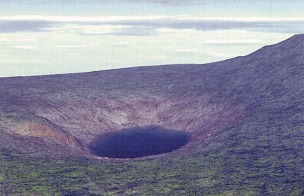Back in 1908 something very big and very unusual happened in Siberia. It caused enormous damage and left locals believing they’d been visited by one of their rather angry gods, Ogdy. Though eyewitnesses spoke of a “split in the sky”, a “second sun”, and being violently thrown to the ground, when the first scientists arrived on the scene 20 years later they found little concrete evidence beyond widespread devastation – there was no tell-tale impact crater or glowing moon rocks. But whatever it was caused the largest natural explosion in recorded history and created a shockwave that circled the Earth…twice. Levelling about 2,000 sq km of forest in the Krasnoyarsk Krai region of Russia, the explosion sent massive amounts of dust into the atmosphere which markedly decreased celestial visibility and reflected so much terrestrial light that Londoners 10,000kms away could read at night.
Speculation about what caused the explosion has ranged from a wayward comet or mini black-hole to a UFO collision. What is generally accepted is that the explosion itself occurred about 6-10 kms above the ground and released 15 megatons of energy – 1000 times more powerful than the Hiroshima atomic bomb. Though there has been little evidence on the ground as to the origins of such a massive airburst recently a team of scientists from Bologna University claimed to have discovered solid proof of a meteorite crater at nearby Lake Cheko.
 By using, first, acoustic imaging and then magnetic and seismic reflection, the Italian team was able to map out the funnel shape of the lake and later identify a “magnetic anomaly…about 10m below the lake floor.” Case closed it would seem. However, researchers from Cornell University have also weighed in, claiming that the Tunguska event was actually a comet which after exploding in the atomosphere, basically melted into thin air. Citing, as a modern-day example, the exhaust plume of the NASA space shuttle, the Cornell scientists claim that the dust which covered the Earth after the event was actually mostly water vapour made up of the remains of the comet. They conclude that the water vapours were carried across the globe by extreme winds which constitute a “totally new and unexpected physics.” How convenient.
By using, first, acoustic imaging and then magnetic and seismic reflection, the Italian team was able to map out the funnel shape of the lake and later identify a “magnetic anomaly…about 10m below the lake floor.” Case closed it would seem. However, researchers from Cornell University have also weighed in, claiming that the Tunguska event was actually a comet which after exploding in the atomosphere, basically melted into thin air. Citing, as a modern-day example, the exhaust plume of the NASA space shuttle, the Cornell scientists claim that the dust which covered the Earth after the event was actually mostly water vapour made up of the remains of the comet. They conclude that the water vapours were carried across the globe by extreme winds which constitute a “totally new and unexpected physics.” How convenient.
Despite these differing theories, the general consensus is that in the early hours of June 30 1908 something fell from the heavens and exploded with terrific force in our atmosphere. According to NASA, Tunguska sized incidents occur relatively frequently, about every 300 years. Since most of the Earth is covered by water, the majority of these strikes have likely detonated harmlessly over an ocean. Taking time and space into account it would seem we were ‘lucky’ that such an event was able to be recorded in the first place. The Russians certainly think highly of the whole episode and have named an anti aircraft/asteroid tank in its honour.
Here’s a longer documentary if you’re interested.

